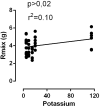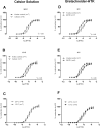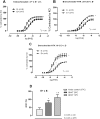Cardioprotective Solutions Exposure For 1 Hour in Hypoxia and Low Temperatures Affects Vascular Reactivity Differently
- PMID: 33355809
- PMCID: PMC8163261
- DOI: 10.21470/1678-9741-2020-0320
Cardioprotective Solutions Exposure For 1 Hour in Hypoxia and Low Temperatures Affects Vascular Reactivity Differently
Abstract
Introduction: Heart preservation benefits cardiac performance after operations decreasing morbidity but the contribution of the vascular reactivity has been neglected.
Methods: We evaluated whether cardioprotective solutions, Krebs-Henseleit (KH), Bretschneider-HTK (BHTK), St. Thomas No. 1 (STH-1), and Celsior (CEL), affect vascular reactivity. Methods: Aortic rings from Wistar rats were used in two protocols. First, the rings were exposed to BHTK, STH-1 or CEL for 1 hour of hypoxia at 37 °C. Second, the rings were exposed to 10 °C or 20 °C for 1 hour under hypoxia. After treatment, the rings were immersed in KH at 37 °C, endothelial integrity was tested and concentration- response curves to phenylephrine were performed.
Results: In the first protocol, the solutions did not damage the endothelium; CEL and BHTK reduced KCl-induced contractions but not STH- 1; only CEL and BHTK reduced vascular reactivity; there was a positive correlation between Rmax and KCl concentration. At 20 °C, 1 hour under hypoxia, the solutions produced similar KCl-induced contractions without endothelial damage. CEL, BHTK and STH-1 decreased vascular reactivity. At 10 °C, STH-1 increased reactivity but CEL and BHTK decreased. After 1 hour under hypoxia in CEL or BHTK solutions, reactivity was similar at different temperatures. At 20 °C, endothelial damage after exposure to STH-1 produced more vasoconstriction than CEL and BHTK. However, at 10 °C, endothelial damage after CEL and BHTK exposure elicited more vasoconstriction while STH-1 showed a small vasoconstrictor response, suggesting endothelial damage.
Conclusion: STH-1 decreased reactivity at 20 °C and increased at 10 °C. CEL promoted greater endothelial modulation at 10 °C than at 20 °C, while STH-1 promoted higher modulation at 20 °C than at 10 °C. Vascular tone was reduced by CEL and BHTK exposure, also depending on the KCl concentration.
Keywords: Hypoxia; Endothelium; Phenylephrine; Temperature; Vasoconstriction; Vasoconstrictor Agents.
Conflict of interest statement
No conflict of interest.
Figures








Similar articles
-
Deleterious effect of hypothermia in myocardial protection against cold ischemia: a comparative study in isolated rat hearts.Transplant Proc. 2012 Oct;44(8):2326-32. doi: 10.1016/j.transproceed.2012.07.007. Transplant Proc. 2012. PMID: 23026585
-
Effect of swimming on vascular reactivity to phenylephrine and KC1 in male rats.Br J Pharmacol. 1995 Jun;115(4):587-94. doi: 10.1111/j.1476-5381.1995.tb14972.x. Br J Pharmacol. 1995. PMID: 7582476 Free PMC article.
-
A comparative study of the most widely used solutions for cardiac graft preservation during hypothermia.J Heart Lung Transplant. 2002 Sep;21(9):1030-9. doi: 10.1016/s1053-2498(02)00414-x. J Heart Lung Transplant. 2002. PMID: 12231375
-
Comparative experimental study of myocardial protection with crystalloid solutions for heart transplantation.Rev Bras Cir Cardiovasc. 2012 Jan-Mar;27(1):110-6. doi: 10.5935/1678-9741.20120016. Rev Bras Cir Cardiovasc. 2012. PMID: 22729308
-
Modulation of temperature-induced tone by vasoconstrictor agents.J Appl Physiol (1985). 1999 Mar;86(3):963-9. doi: 10.1152/jappl.1999.86.3.963. J Appl Physiol (1985). 1999. PMID: 10066711
References
-
- Demmy TL, Biddle JS, Bennett LE, Walls JT, Schmaltz RA, Curtis JJ. Organ preservation solutions in heart transplantation--patterns of usage and related survival. Transplantation. 1997;63(2):262–269. - PubMed
-
- Marshall VC. Morris PJ. Kidney transplantation. Principles and practice. Philadelphia: WB Saunders; 2000. Renal preservation; pp. 113–134.
-
- Kumar MS, Samhan M, al Sabawi N, al Abdullah IH, Silva OS, White AG, et al. Preservation of cadaveric kidneys longer than 48 hours: comparison between euro-collins solution, UW solution, and machine perfusion. Transplant Proc. 1991;23(5):2392–2393. - PubMed
Publication types
MeSH terms
Substances
LinkOut - more resources
Full Text Sources
Research Materials
Miscellaneous
